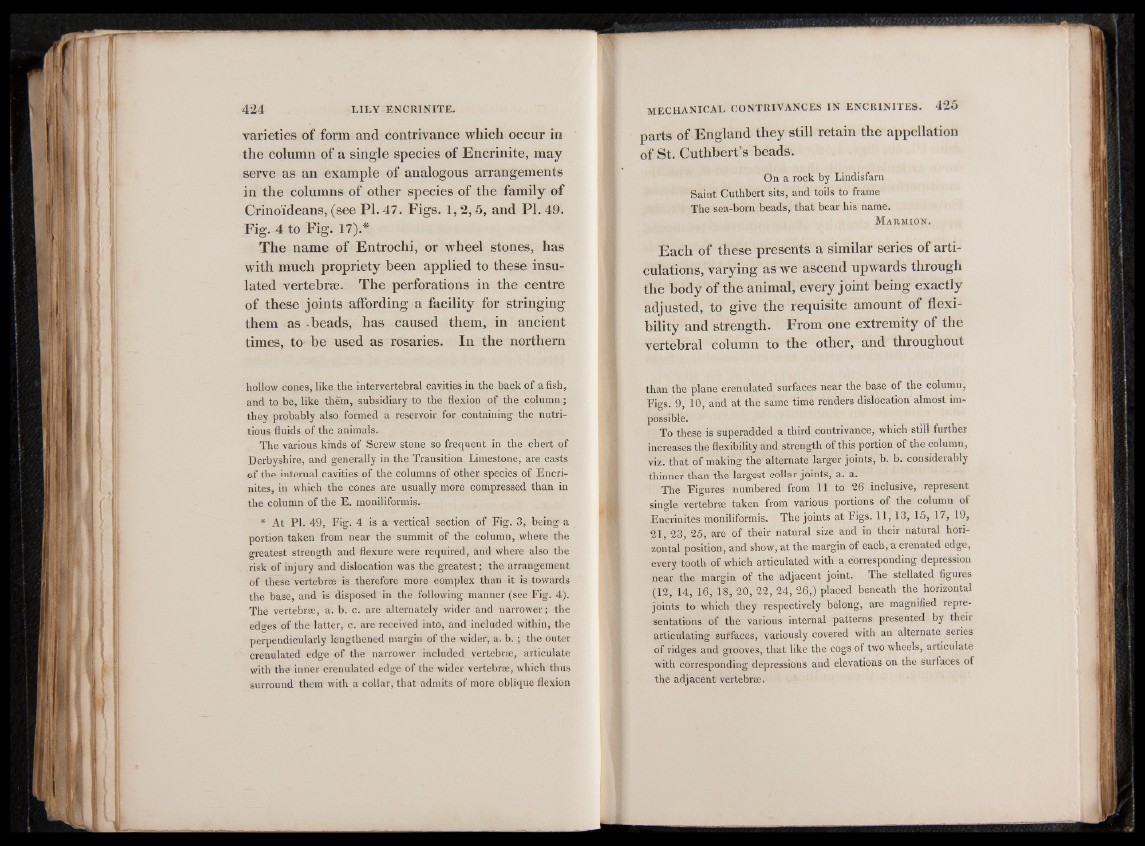
varieties of form and contrivance which occur in
the column of a single species of Encrinite, may
serve as an example of analogous arrangements
in the columns of other species of the family of
Crinoideans, (see Pl. 47. Figs. 1, 2,5, and PI. 49.
Fig. 4 to Fig. 17).*
The name of Entrochi, or wheel stones, has
with much propriety been applied to these insulated
vertebrae. The perforations in the centre
of these joints affording a facility for stringing
them as heads, has caused them, in ancient
times, to be used as rosaries. In the northern
hollow cones, like the intervertebral cavities in the back of a fish,
and to be, like them, subsidiary to the flexion of the column ;
they probably also formed a reservoir for containing the nutritious
fluids of the animals.
The various kinds of Screw stone so frequent in the chert of
Derbyshire, and generally in the Transition Limestone, are casts
of the internal cavities of the columns of other species of Encri-
nites, in which the cones are usually more compressed than in
the column of the E. moniliformis.
* At PI. 49, Fig. 4 is a' vertical section of Fig. 3, being a
portion taken from near the summit of the column, where the
greatest strength and flexure were required, and where also the
risk of injury and dislocation was the greatest; the arrangement
of these vertebrse is therefore more complex than it is towards
the base, and is disposed in the following manner (see Fig. 4).
The vertebrse, a. b. c. are alternately wider and narrower; the
edges of the latter, c. are received into, and included within, the
perpendicularly lengthened margin of the wider, a. b .; the outer
crenulated edge of the narrower included vertebrse, articulate
with the inner crenulated edge of the wider vertebrse, which thus
surround them with a collar, that admits of more oblique flexion
parts of England they still retain the appellation
of St. Cuthbert’s beads.
On a rock by Lindisfarn
Saint Cuthbert sits, and toils to frame
The sea-born beads, that bear his name.
M ahmio n .
Each of these presents a similar series of articulations,
varying as we ascend upwards through
the body of the animal, every joint being exactly
adjusted, to give the requisite amount of flexibility
and strength. From one extremity of the
vertebral column to the other, and throughout
than the plane crenulated surfaces near the base of the column,
Figs. 9, 10, and at the same time renders dislocation almost impossible.
To these is superadded a third contrivance, which still further
increases the flexibility and strength of this portion of the column,
viz. that of making the alternate larger joints, b. b. considerably
thinner than the largest collar joints, a. a.
The Figures numbered from 11 to 26 inclusive, represent
single vertebrse taken from various portions of the column of
Encrinites moniliformis. The joints at Figs. 11,13, 15, 17, 19,
21, 23, 25, are of their natural size and in their natural horizontal
position, and show, at the margin of each, a crenated edge,
every tooth of which articulated with a corresponding depression
near the margin of the adjacent joint. The stellated figures
(12, 14, 16, 18, 20, 22, 24, 26,) placed beneath the horizontal
joints to which they respectively belong, are magnified representations
of the various internal patterns presented by their
articulating suffaces, variously covered with an alternate series
of ridges and grooves, that like the cogs of two wheels, articulate
with corresponding depressions and elevations on the surfaces of
the adjacent vertebrse.